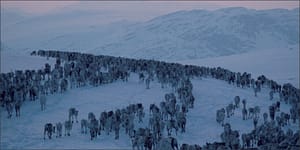Hope for a Thirsty World

Judith D. Schwartz is a journalist whose recent work looks at soil as a hub for multiple environmental, economic, and social challenges and solutions. She writes on this theme for numerous publications and speaks at venues around the world. Her 2013 book Cows Save the Planet was awarded a Nautilus Book Award Silver Prize for Sustainability and was among Booklist’s Top 10 Books on Sustainability in 2014. A graduate of the Columbia Journalism School and Brown University, she lives in Vermont.
The following is an excerpt from Water in Plain Sight by Judith Schwartz. It has been adapted for the web.
Chihuahua, Mexico’s largest state is big ranching country. The Chihuahuan Desert region, which includes parts of Arizona, New Mexico, and Texas as well as the northern Mexico states of Chihuahua and Coahuila, is where many of the cowboy traditions we associate with “the West” originated. “It was the ideal place to raise cattle,” says rancher Alejandro Carrillo, “thanks to a sea of native grasslands and plenty of water from year-round springs.”
I came to Chihuahua to see the birds. Upon seeing my book Cows Save the Planet a few months prior, Carrillo had contacted me and told me that he and fellow ranchers who practice holistic planned grazing were working with bird conservation organizations to protect endangered migratory grassland bird populations. Several species of grassland birds, including certain song sparrows and the lark bunting, the state bird of Colorado, have seen tremendous drops in numbers—in some cases upward of 80 percent.
For a long time conservationists concerned about these birds had concentrated on the summer breeding habitat in the Western Great Plains.
They’ve since come to realize that the deterioration of winter habitat, where the birds spend seven months of the year, could represent the largest threat to their survival.

The good news, says Carrillo, is that they know how to grow grass, and therefore create bird habitat, through holistic planned grazing. At Las Damas Ranch “we used to have just two species, tobosa and zacaton,” he says, referring to native perennial grasses that can survive through droughts and overgrazing. “Now we have multiple grasses, some taller than myself. People didn’t think it was possible to have these grasses in the desert.” The result of the renewed growth of diverse grasses is that the ranch is “a magnet for birds. You can see migratory, predator, nonpredator birds. In much of the state, in February and March there’s no grass at all.”
That this small group of ranches constitutes oases of bird habitat attracted the attention of conservation groups working to protect threatened bird populations. The conservation groups are now collaborating with five ranchers, with the possibility of more, to monitor bird numbers and expand the amount of land with favorable bird habitat. Ideally, they’re seeking to create a biological corridor that will offer protection for desert grassland birds so that their populations can rebound.
Andrew Rothman, director of the Migratory Bird Program at the American Bird Conservancy, has visited Las Damas Ranch several times. “It was pretty evident right away that the amount of grasses there was superior to pretty much any land we’d seen in the Chihuahuan Desert,” he told me. “That land was different, with plenty of vegetation and forage for cattle. What’s good forage for cattle is good habitat for birds.”
Rothman’s field observations in Chihuahua challenged some of his earlier assumptions about wildlife conservation. “Our perception of conservation is often [to] set the land aside and not do anything,” he said. “But many of our habitats are disturbed.” In North American grasslands, for instance, there would be occasional, limited lightning-kindled fires or trampling from passing bison herds. “Cattle re-create some of those disturbances,” he said. “This can help regenerate the landscape when properly managed.”
Recommended Reads
Recent Articles
This long-lived perennial legume is used for forage and erosion control. Kudzu is edible with many medicinal uses and other applications. Pollinators of all kinds love its prodigious lavender blooms!
Read MoreMove aside, maple! We have two new syrups to add to the table. Read on for insights on tapping, selling, and eating syrup from walnut & birch trees.
Read MoreWhy is modern wheat making us sick? That’s the question posed by author Eli Rogosa in Restoring Heritage Grains. Wheat is the most widely grown crop on our planet, yet industrial breeders have transformed this ancient staff of life into a commodity of yield and profit—witness the increase in gluten intolerance and ‘wheat belly’. Modern…
Read MoreDid you ever wonder how leeks, kale, asparagus, beans, squash, and corn have ended up on our plates? Well, so did Adam Alexander, otherwise known as The Seed Detective. The following is an excerpt from the The Seed Detective by Adam Alexander. It has been adapted for the web. My Seed-Detective Mission Crammed into two…
Read MoreMost people know that the big man in the North Pole has a team of reindeer waiting to deliver presents, but not as many know who is taking care of these animals behind the scenes: the Sámi people of Norway. This is an excerpt from The Reindeer Chronicles by Judith D. Schwartz. It has been…
Read More








